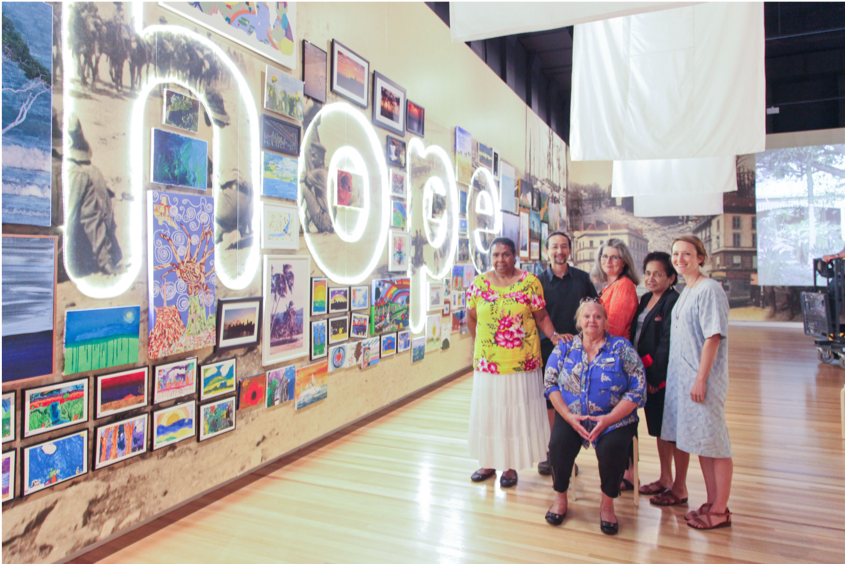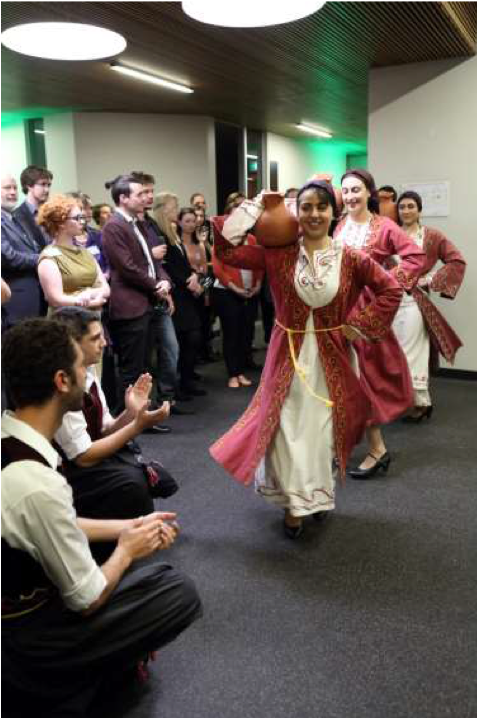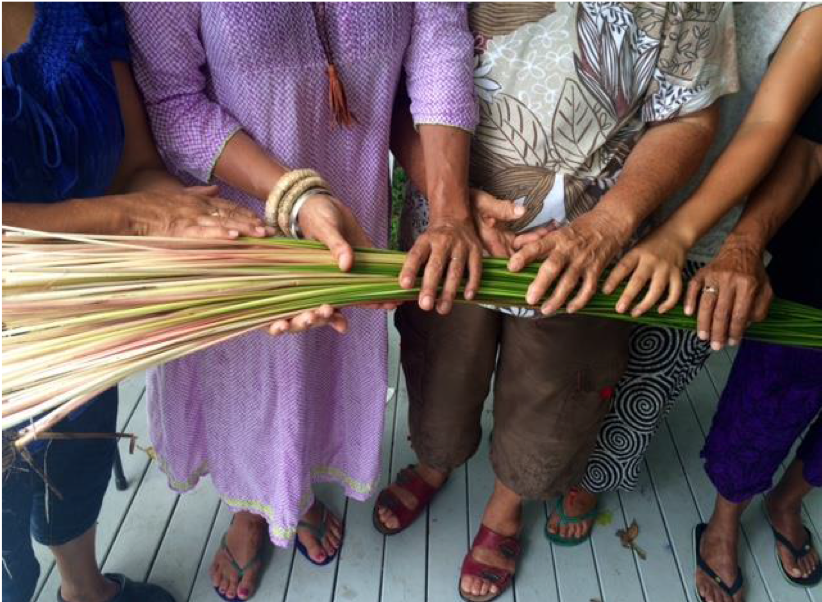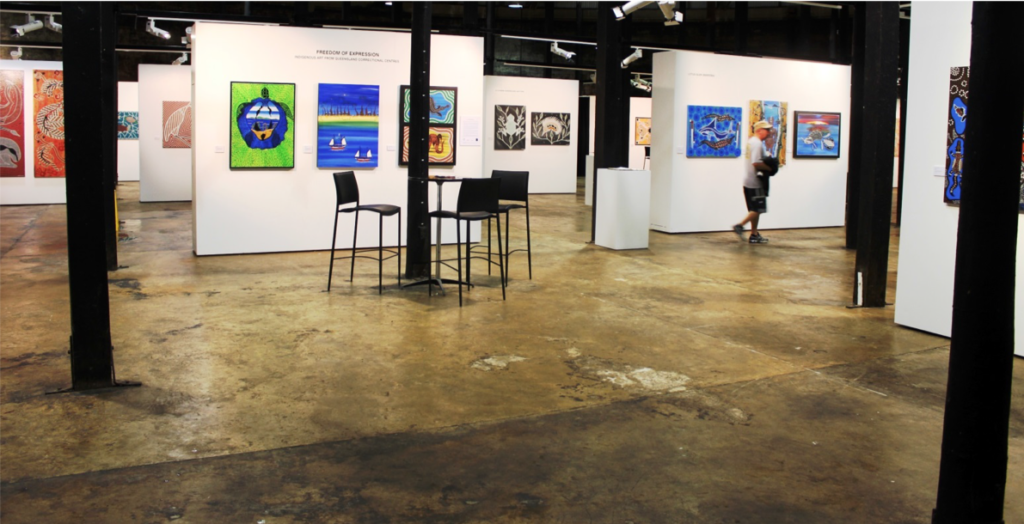Winner

State Library of Queensland
Peace and Quiet
Peace and Quiet was a major exhibition that took place in the State Library of Queensland (SLQ) Gallery from November 2015 to February 2016. Initially conceived as a small installation, it was recognised that the concept could become a full exhibition able to encompass the whole gallery with substantial community input.
Peace and Quiet was designed to provide a debate between the opposing concepts of peace and war. It explored personal, social and political ideas of peace, and was led by Queensland artists Elizabeth Woods and Kevin Leong. The exhibition dealt with the Peace movement and its relation to politics and broader social change. It also explored the domestic notion of the need for quiet in a world where we are constantly bombarded with information.
The Peace and Quiet exhibition represented a new community engagement model for SLQ – developing works with the community; providing a more accessible portal for others to contribute exisiting work; and allowing the community to provide loan items. A number of community and stakeholder groups helped to build the exhibition components, including: The Peace Interviews, a collection of texts and photographs from a range of community members who had experienced war either as soldiers or refugees; White Flags: 12 hand-stitched country of origin flags made by community groups using only white fabric; a performance video of community members performing the semaphore sign for nuclear disarmament; more than 260 peaceful landscape artworks contributed by Queensland artists, hung around the words “Hope” and “Less”; a collection of early and current peace placards, banners and posters sourced from the Peace movement; and objects used in peaceful or anti-war protests.
The Peace and Quiet exhibition brought a more culturally diverse audience to the SLQ Gallery, especially as many culturally diverse people were heavily engaged in making the exhibition. It also resulted in developing an ongoing relationship with the ‘Peace’ community as a new key audience. More than 5,000 people attended the exhibition over 67 days.
Finalists

R.D. Milns Antiquities Museum, The University of Queensland
‘Cyprus: An Island and A People’ Exhibition and Public Programs
The R.D. Miles Antiquities Museum is located at The University of Queensland campus in St Lucia, Brisbane.
In 2014, the Museum sought to connect with a new audience, the Cypriot Community of Brisbane, whom they hopes would be inspired to take an interest in the Museum’s collection, especially its artefacts from the island of Cyprus.
Their major exhibition, Cyprus: An Island and A People held in 2014-2015, aimed not only to explore the important place of Cyprus in the ancient world, but to highlight the connection of the modern Cypriot community to their ancient past.
In the planning stages of the exhibition, Museum staff made contact with the Cypriot Community Association of Queensland to discuss the ways in which the community might like to be involved in the exhibition, and subsequently developed a suite of public programs to complement the exhibition designed specifically to connect with this new audience and to extend existing visitor engagement. These programs included the Exhibition and Exhibition Opening event; two Public Panels (Cyprus Curator Panel and Doing Archaeology on Modern Cyprus); and an Interactive Public Event, Cyprus Up Late, featuring Cypriot dance and cooking, and ancient and modern games from Cyprus.
The project enabled the Museum to introduce new audiences to the Cypriot artefacts in the collection, and to develop an ongoing relationship with the Cypriot community.

Redland Art Gallery
Gathering Strands
Redland Art Gallery opened in 2003 and is located in Redland City, east of Brisbane.
Gathering Strands was a multi-layered exhibition project celebrating the vitality of Indigenous fibre work by bringing together Aboriginal and Torres Strait Islander weavers, visual artist and community groups from across South East Queensland. Curated by Freja Carmichael, recipient of the 2014 Australia Council Emerging Curator’s Fellowship, Gathering Strands was the culmination of a two-year journey that embodied a strong focus on strengthening practices locally, and offering connection through fibre-based traditions.
Gathering Strands fostered new relationships and networks for Redland Art Gallery between artists, community members, organisations/institutions and businesses, including the input of 22 Aboriginal and Torres Strait Islander artists; an exhibition publication partnership with Gilimbaa, Indigenous creative agency; and working with the Quandamooka Festival and the Quandamooka Yoolooburrabee Aboriginal Corporation.
The exhibition was displayed at Redland Art Gallery from June to July 2016, and included commissioned pieces; Redland Art Gallery collection works; and historical material collected from Stradbroke Island, from The University of Queensland Anthropology Museum Collection.
Through the workshops and exchanging of stories and knowledge in the exhibition, Gathering Strands brought together generations, family groups and communities. In the series of weaving workshops held on Minjerribah, Elders and generations of women worked together to learn and share. The exhibition opening weekend and public programs provided a platform for artists, families, the Quandamooka community and broader community to come together in celebration. This provided a chance for new connections to form locally at Redland Art Gallery and broadly across South East Queensland.

Tanks Arts Centre, Cairns Regional Council
Freedom of Expression: Indigenous Art from Queensland Correctional Centres
Tanks Arts Centre, Cairns Regional Council, is a multi-arts centre converted from three ex-WWII oil storage tanks and is a heritage-listed site.
Cairns Indigenous Art Fair (CIAF) is Australia’s premier Indigenous art fair, and annual event presenting contemporary Indigenous art, music, dance, fashion and culture of Queensland.
Freedom of Expression: Indigenous Art from Queensland Correctional Centres was a CIAF satellite exhibition held at the Tanks Arts Centre gallery in July 2016. The exhibition showed Indigenous prisoners’ artworks from four correctional centres in Queensland: Lotus Glen Correctional Centre (Mareeba); Capricornia Correctional Centre (Rockhampton); Maryborough Correctional Centre; and Southern Queensland Correctional Centre (Gatton); and was co-curated by CIAF Artistic Director, Janina Harding, and Tanks Arts Centre Curator, Chris Stannard.
For prisoners, any audience on the outside is a new audience. This was the first State-wide exhibition of its scale and profile in Queensland. As a satellite exhibition for CIAF, it was able to attract 3,300 visitors, including influential Collectors and Curators. Introductions were made between those who work inside the prison system and those in the arts and cultural sector who are in a position to advance further projects.
Throughout the project, the Co-curators aimed to preserve ownership of the exhibition in the hands of the artists rather than in the prison system, by brokering permissions and finding ways to bring the personality and cultural identity of the artists into the exhibition.
The legacy of the exhibition will be that many participating artists have been offered first steps along a career path prior to their release. Their artwork has been professionally valued; they have been publicly recognised for their talent; and they have experienced the work that goes into entering artworks in a public exhibition.

